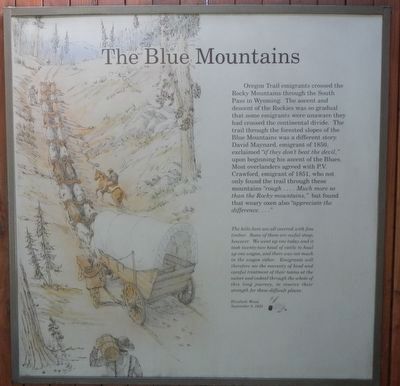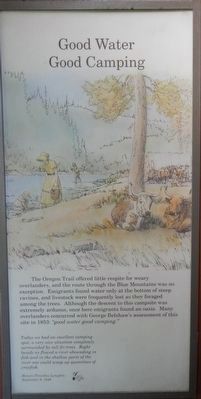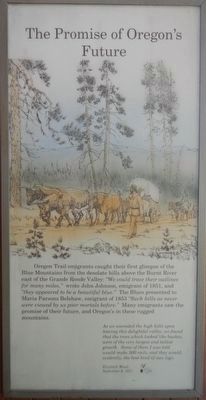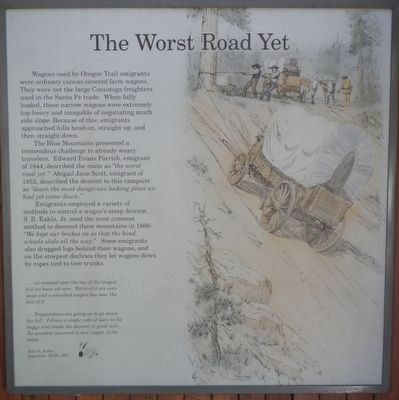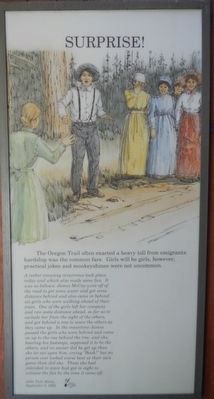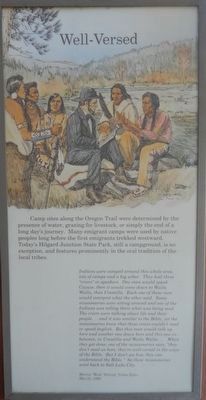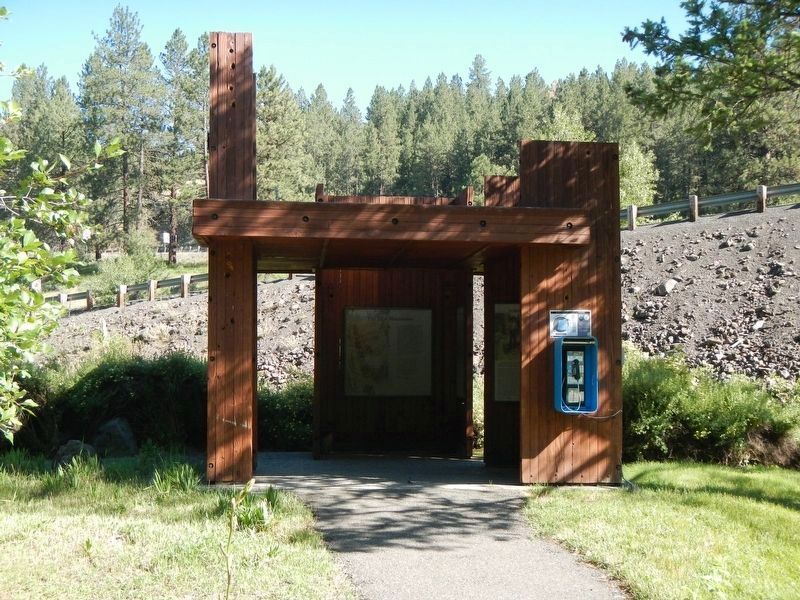Near La Grande in Union County, Oregon — The American West (Northwest)
Hilgard Junction Oregon Trail Kiosk
Oregon Trail emigrants crossed the Rocky Mountains through South Pass in Wyoming. The ascent and descent of the Rockies was so gradual that some emigrants were unaware they had crossed the continental divide. The trail through the forested slopes of the Blue Mountains was a different story. David Maynard, emigrant of 1850, exclaimed "if they don't beat the devil," upon beginning his ascent of the Blues. Most overlanders agreed with P.V. Crawford, emigrant of 1851, who not only found the trail through these mountains "rough .... Much more so than the Rocky mountains," but found that weary oxen also "appreciated the difference...."
The hills here are all covered with fine timber. Some of them are awful steep, however. We went up one today and it took twenty-two head of cattle to haul up one wagon, and there was not much in the wagon either. Emigrants will therefore see the necessity of kind and careful treatment of their teams at the outset and indeed through the whole of this long journey, to reserve their strength for these difficult places. -- Elizabeth Wood, September 9, 1851
The Oregon Trail offered little respite for weary overlanders, and the route through the Blue Mountains was no exception. Emigrants found water only at the bottom of steep ravines, and livestock were frequently lost as they foraged among the trees. Although the descent to this campsite was extremely arduous, once here the emigrants found an oasis. Many overlanders concurred with George Belshaw's assessment of this site in 1853: "good water good camping."
Today we had an excellent camping spot, a very nice situation completely surrounded by tall trees. Right beside us flowed a river abounding in fish and in the shallow parts of the river one could scoop up quantities of crayfish. -- Honore-Timothy Lempfrit, September 9, 1848
Oregon Trail emigrants caught their first glimpse of the Blue Mountains from the desolate hills above the Burnt River east of the Grande Ronde Valley: "We could trace their outlines for many miles," wrote John Johnson, emigrant of 1851, and "they appeared to be a beautiful blue." The Blues presented to Maria Parsons Belshaw, emigrant of 1853, "Such hills as never were viewed by us poor morals before." Many emigrants saw the promise of their future, and Oregon's in these rugged mountains.
As we ascended the high hills upon leaving this delightful valley, we found that the trees which looked like bushes, were of the very largest and tallest growth. Some of them I was told would make 300 rails, and they would evidently, the best kind of saw logs. -- Elizabeth Wood, September 9, 1851
Wagons used by Oregon Trail emigrants were ordinary canvas-covered farm wagons. They were not the large Conestoga freighters used in the Santa Fe trade. When fully loaded, these narrow wagons were extremely top-heavy and incapable of negotiating much side slope. Because of this, emigrants approached hills head-on, straight up and then straight down.
The Blue Mountains presented a tremendous challenge to already weary travelers. Edward Evans Parrish, emigrant of 1844, described the route as "the worst road yet." Abigail Jane Scott, emigrant of 1852, described the descent to this campsite as "down the most dangerous looking place we had yet came down."
Emigrants employed a variety of methods to control a wagon's steep descent. S.B. Eakins, Jr. used the most common method to descent these mountains in 1866: "we kept our brakes on so that the hind wheels slide all the way." Some emigrants also dragged logs behind their wagons, and on the steepest declines they let the wagons down by ropes tried to tree trunks.
... we camped near the top of the longest hill we have yet seen. Parts of it are very steep and a smashed wagon lies near the foot of it.
... Preparations are going on to go down the hill. I drove a single yoke of oxen to the buggy and made the descent in good style. No accident occurred to any wagon of the train.... -- John S. Zieber, September 19-20, 1851
The Oregon Trail often exacted a heavy toll from emigrants: hardship was the common fare. Girls will be girls, however; practical jokes and monkeyshines were not uncommon.
A rather amusing occurrence took place today and which also made some fun. It was as follows: James McCoy went off of the road to get some water and got some distance behind and also came in behind six girls who were walking ahead of their train. One of the girls left her company and ran some distance ahead, so far as to exclude her from the sight of the others, and got behind a tree to scare the others as they came up. It the meantime James passed the girls who were behind and came on up to the one behind the tree, and she, hearing his footsteps, supposed it to the others, and no sooner did he get up than she let out upon him, crying "Booh!" but no person ever looked worse beat at their own game that did she. Those she had intended to scare had got in sight to witness the fun by the time it came off. -- John Tully Kerns, September 3, 1852
Camp sites along the Oregon Trail were determined by the presence of water, grazing for livestock, or simply the end of a long day's journey. Many emigrant camps were used by native peoples long before the first emigrants trekked westward. Today's Hilgard Junction State Park, still a campground, is no exception, and features prominently in the oral tradition of the local tribes.
Indians were camped around this whole area, lots of camps and a big arbor. They had three "criers" or speakers. One man would speak Cayuse, then it would come down to Walla Walla, then Umatilla. Each one of these men would interpret what the other said. Some missionaries were sitting around and one of the Indians was telling them what was being said. The criers were talking about life and their people... and it was similar to the Bible, yet the missionaries knew that these criers couldn't read or speak english. But this man would talk up here and another one down here and this one in between, in Umatilla and Walla Walla... When they got done, one of the missionaries says, "they don't need us here, they're well-versed in the ways of the Bible. But I don't see how they can understand the Bible." So these missionaries went back to Salt Lake City. -- Marvin "Wish" Patrick, Tribal Elder, May 21, 1992 (sic)
Erected by Oregon Trail Coordinating Council (OTCC).
Topics and series. This historical marker is listed in these topic lists: Roads & Vehicles • Settlements & Settlers. In addition, it is included in the Oregon Trail series list. A significant historical date for this entry is May 21, 1992.
Location. 45° 20.515′ N, 118° 14.075′ W. Marker is near La Grande, Oregon, in Union County. Marker can be reached from Hilgard Highway (Oregon Route 244) near Interstate 84. Touch for map. Marker is in this post office area: La Grande OR 97850, United States of America. Touch for directions.
Other nearby markers. At least 8 other markers are within 6 miles of this marker, measured as the crow flies. "Wagons East " 1975-1976 (here, next to this marker); Highway US30 and Perry, Oregon (approx. 3.2 miles away); Conde B. McCullough and Upper Perry Arch Bridge (approx. 3.2 miles away); A Beautiful Rough Road (approx. 5˝ miles away); A Native American Trail (approx. 5˝ miles away); Parade of Survivors (approx. 5.6 miles away); On This Ridge... (approx. 5.6 miles away); Wagon Wheels to Automobiles (approx. 5.6 miles away). Touch for a list and map of all markers in La Grande.
More about this marker. The kiosk is located at Hilgard Junction State Park which is just off of Interstate 84, Exit 252.
Credits. This page was last revised on July 21, 2023. It was originally submitted on December 13, 2017, by Barry Swackhamer of Brentwood, California. This page has been viewed 333 times since then and 19 times this year. Photos: 1, 2, 3, 4, 5, 6, 7. submitted on December 13, 2017, by Barry Swackhamer of Brentwood, California.
